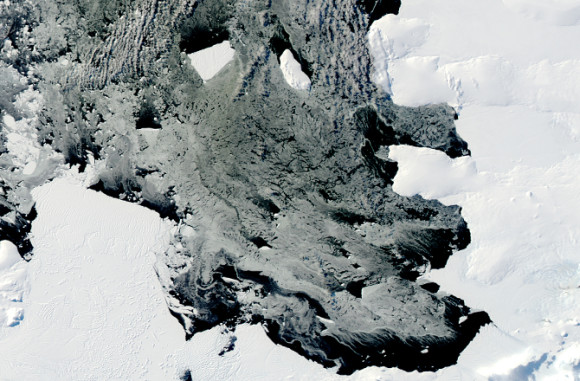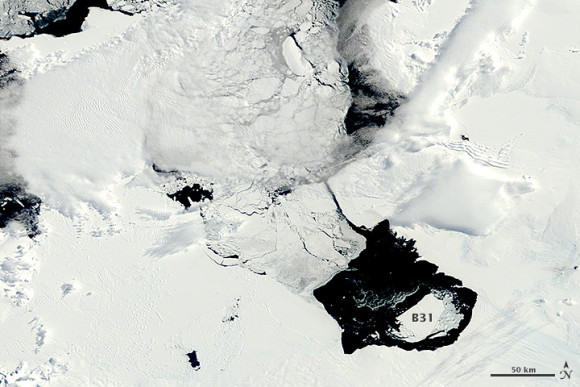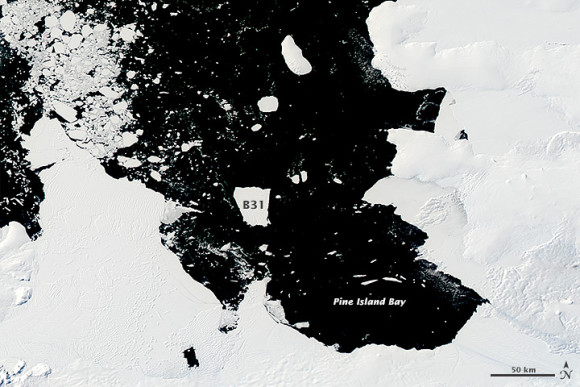NASA is tracking a gargantuan iceberg, escaped from Antarctica
NASA has been tracking the huge iceberg B31, which broke away from Antarctica’s Pine Island Glacier in November 2013. Now, though, southern winter is coming.

B31 is a huge ice island, currently floating in the Amundsen Sea. The 20-mile (33 kilometer) by 12 mile (20 kilometer) iceberg is expected to pass into the Southern Ocean soon. Image via Jeff Schmaltz, LANCE/EOSDIS Rapid Response.
NASA is tracking an iceberg – an ice island, really – 240 square miles (over 600 square kilometers). That’s in contrast to about 23 square miles for New York’s Manhattan Island. Scientists have labeled this iceberg as B31. It separated from the front of Antarctica’s Pine Island Glacier last November and began a journey across Pine Island Bay, a basin of the Amundsen Sea. It’ll likely be swept up soon in the swift currents of the Southern Ocean, and it will soon be hard to track visually because the Antarctic is heading into winter darkness for the coming six months.
The significance of this large iceberg is still being sorted out, NASA says. Kelly Brunt, a glaciologist at NASA’s Goddard Space Flight Center, noted:
Iceberg calving is a very normal process. However, the detachment rift, or crack, that created this iceberg was well upstream of the 30-year average calving front of Pine Island Glacier, so this a region that warrants monitoring.
Pine Island Glacier itself – the source of the massive iceberg – has been the subject of intense study in the past several decades. Scientists speak of this glacier as the weak underbelly of the West Antarctic Ice Sheet. The glacier has been thinning and draining rapidly and may be one of the largest contributors to sea level rise. Read more: As ocean warms, Antarctica’s Pine Island Glacier thaws
Large icebergs like this one pose a danger to ships. Our modern shipboard technologies – radar and warning systems – can’t always prevent accidents. For example, in 2007, the MS Explorer, an Antarctic cruise ship, sank after striking an iceberg near the South Shetland Islands. Read more at CBS News.

The ice island B31 broke away from Pine Island Glacier in early November 2013. Scientists say that while it lost some mass very early on in its life as a floating iceberg, it has remained pretty much the same shape since early December. As of April 11, 2014, the U.S. National Ice Center (NIC) reported that the iceberg is 33 kilometers long and 20 kilometers wide (18 by 11 nautical miles).

Over the course of five months in Antarctic spring and summer, NASA has been using both its Terra and Aqua satellites to capture images of the massive floating ice chunk. One of the scientists involved, Grant Bigg of the University of Sheffield, said, “We are doing some research on local ocean currents to try to explain the motion properly. It has been surprising how there have been periods of almost no motion, interspersed with rapid flow. There were a couple of occasions early on when there might have been partial grounding or collisions with the seafloor, as B31 bounced from one side of the Bay to the other.”

In the coming months, B31 is expected to leave the Amundsen Bay and enter the waters of the Southern Ocean. Since southern winter is approaching, bringing day-long darkness to that part of the world, and the iceberg will be harder to track visually.
Bottom line: NASA is tracking the huge iceberg B31, which broke away from Antarctica’s Pine Island Glacier in November 2013. Winter is now approaching in the southern part of the world, and thus the iceberg – which is about six times the size of Manhattan Island, and perhaps 500 meters thick – will soon be hard to track visually.
Δεν υπάρχουν σχόλια:
Δημοσίευση σχολίου
NO COMMENTS!